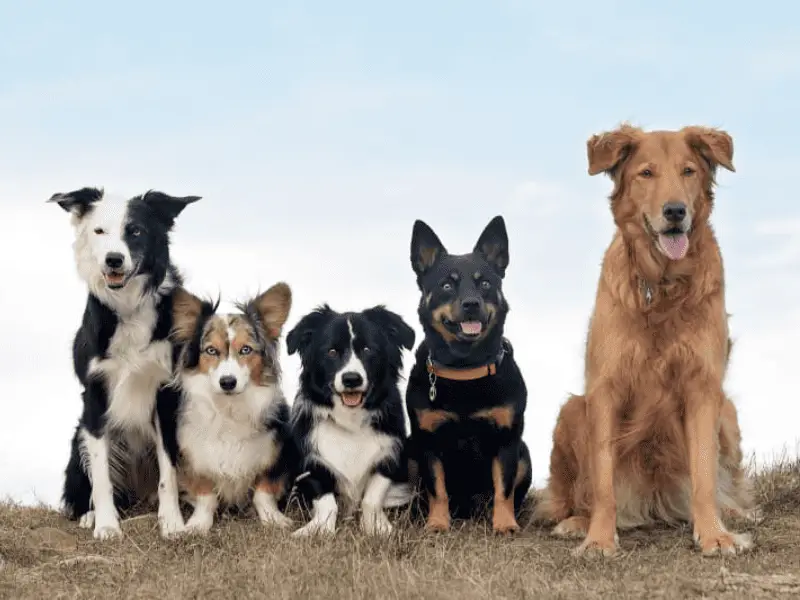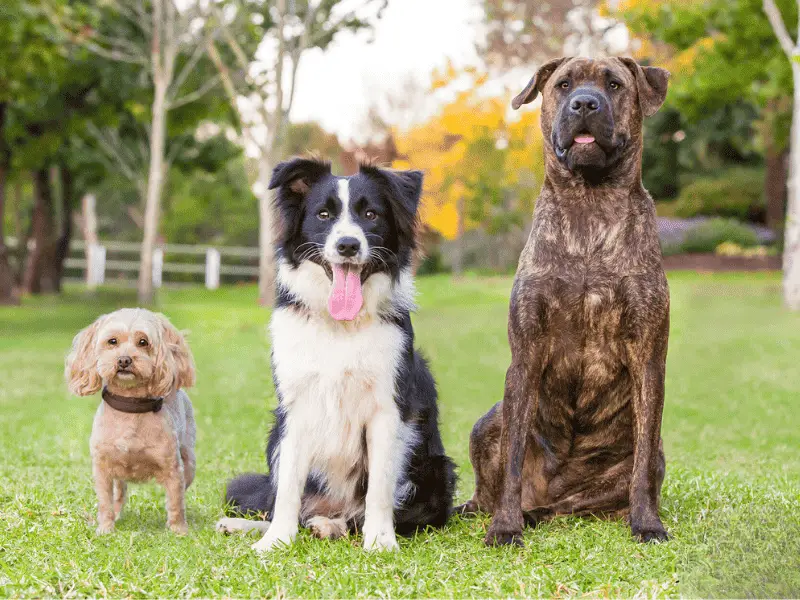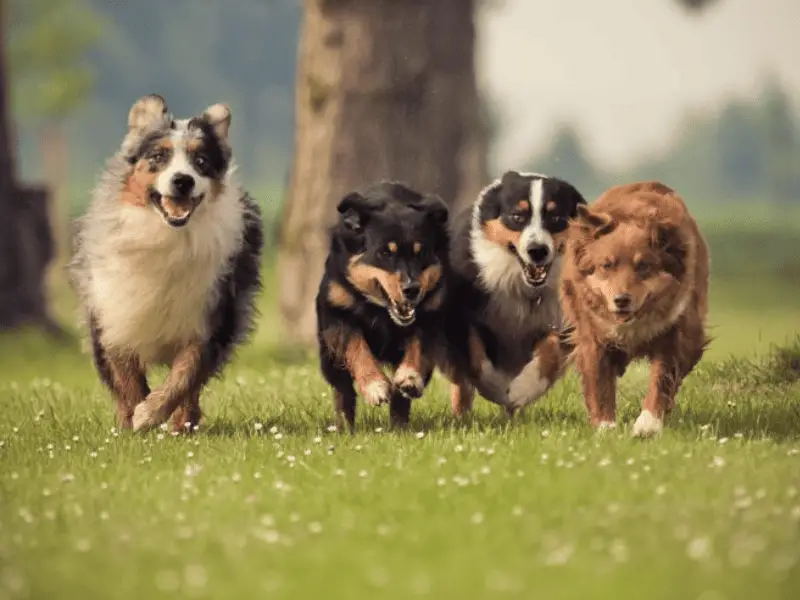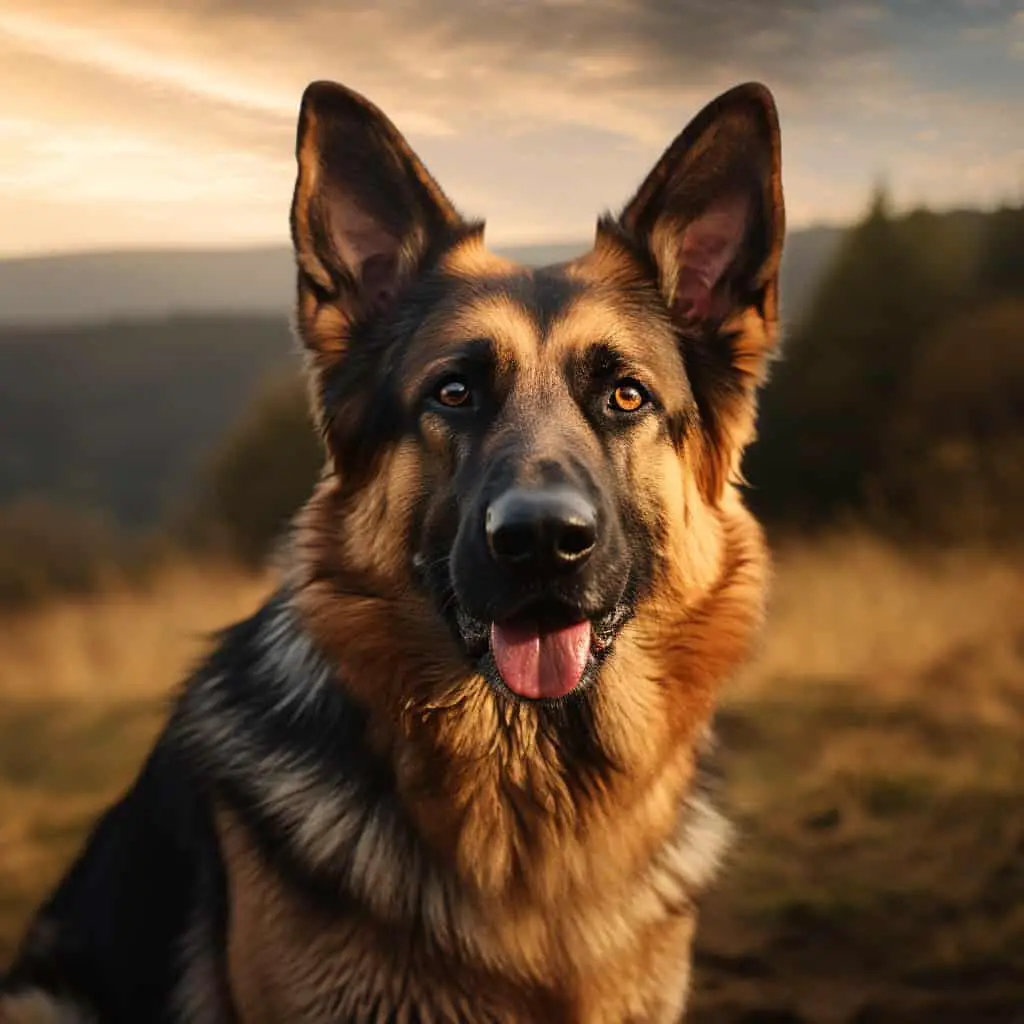Dog size comparison, understanding how your dog will grow, and predicting its adult size are crucial for many dog owners. In this section, we’ll explore the importance of predicting a dog’s adult size and the factors that come into play when making size predictions.

We’ll also delve into different formulas based on breed that can help estimate your pup’s size as they mature. With this knowledge, you can gain valuable insights into your canine companion’s development and ensure their needs are met as they grow.
Importance of Predicting a Dog’s Adult Size
Predicting a dog’s adult size is essential. It helps owners make the right decisions for their pup’s future – like choosing the right puppy for their home, and the correct size of clothing, beds, collars, bandanas, harnesses and pet doors. Plus, it can also help owners decide the best diet and exercise for their furry pal. Predictions based on breed give insight into the pup’s growth trajectory and any potential health issues linked to size.
Toy breeds usually mature quickly, while bigger breeds take more time. DNA testing, studying the size, weight and structure of both parents and considering coat density, bone structure and head size, all play a part in predicting the adult size.
It’s not just curiosity; size predictions have practical implications. Knowing the size allows owners to provide the right-sized items, preventing harm caused by ill-fitting items. By recognizing the importance of size predictions, owners can make sure their pet is comfortable and well-cared for.
In the end, size predictions need careful consideration of genetics, breed characteristics and a bit of guesswork.
Factors To Consider for Size Predictions
Size predictions for dogs require factoring in various elements that can affect their adult size. These include: breed genetics, growth patterns, and individual differences. Looking at these components carefully can help owners and breeders make more precise forecasts of a pup’s size when they are fully grown.
- Breed Genetics: Dog breeds have distinct genetic attributes that impact their size. Details like parent size and the breed’s growth trends can help give an idea of how large the pup will be.
- Growth Patterns: It’s key to understand the typical growth patterns for various breeds. Small and toy breeds reach full size more quickly than larger breeds, who may continue to grow for longer.
- Individual Variations: Even within a breed, dogs may differ in their rate of growth and final size. Nutrition, exercise, and health all play a role.
- Environmental Factors: Raising a pup in the right environment can have an effect on their size. Proper nutrition, care, and exercise can help maximize their growth.
By considering these factors, owners and breeders can make informed guesses about a pup’s size. However, there can still be some degree of unpredictability when it comes to a dog’s exact adult size. Trying to predict your dog’s size? It’s like forecasting the weather in New England – always exciting!
Different Formulas for Size Predictions Based on Breed
Formulas to predict a dog’s size based on its breed have been used for many years. The formulas take into account growth patterns, genetics and physical characteristics.
To help dog owners, a table can be created with the breeds and the relevant formula or method to predict adult size. DNA testing and the size, weight, and structure of both parents are also important for size prediction. Coat type, bone structure and head size also provide clues as to whether the dog will be larger or smaller than average for its breed.
Using formulas for size prediction helps breeders make informed decisions about breeding partners and future homes for the dogs. They are valuable tools for selecting suitable puppies based on their potential adult sizes.
Growth Patterns for Different Breed Sizes
When it comes to dog size, understanding the growth patterns for different breed sizes is essential. In this section, we’ll explore the various sub-sections that cover toy breeds, small breeds, medium breeds, large breeds, and giant breeds. Get ready to dive into the fascinating world of how our furry companions measure up!
Toy Breeds
Toy breeds are among the smallest of dog breeds. They weigh 4-7 pounds and stand under 10 inches tall. Adorable and delicate, they make great companions due to their size and often have longer lifespans. Perfect for apartments, they require minimal exercise and have a friendly temperament.
Unfortunately, their small size also makes them prone to health issues such as dental problems, developmental issues, and breathing problems. Extra care must be taken when handling toy breeds to avoid injury. Grooming is important to keep them healthy and happy.
Toy breed puppies grow rapidly in the first few months before reaching adult size by 9-12 months. Closely monitoring their growth is essential to staying within expected ranges.
Take Coco, for example. She was a tiny Chihuahua who chased after birds in the park despite her size. She showed us that size doesn’t matter when it comes to love and companionship. Small breeds are proof that good things come in tiny packages – just make sure you have a magnifying glass to find them!
Small Breeds
Small breeds of dogs are known for their small size, delicate features, and often friendly temperaments. These pups usually weigh between two and twenty-two pounds as adults.

There’s a way to compare and contrast the different breeds: create a table with columns for breed name, weight, and characteristics. Remember, though, that each breed has its own unique details. For instance, they may need special care due to their size. It’s important for owners to be aware of this.
Table: Small Dog Breeds
| Breed Name | Weight | Characteristics |
|---|---|---|
| Charlie | Small | Bold, loyal, brave |
One charming example is Charlie. Despite his tiny size, Charlie was bold and loyal. When a bigger dog came near him during a park stroll, he bravely defended his owner. This proves that size doesn’t matter when it comes to love and loyalty.
Medium Breeds
Medium-sized dog breeds are important to consider when discussing the growth and size of dogs. These breeds lie between toy and small breeds, and have unique features. Let’s explore their growth patterns by looking at height, weight, and development milestones.
Below is a table with some popular medium-sized breeds and their average adult measurements:
| Breed | Height (inches) | Weight (pounds) |
|---|---|---|
| Golden Retriever | 20-24 | 55-75 |
| Cocker Spaniel | 14.5-15.5 | 24-28 |
| Border Collie | 18-22 | 30-55 |
Medium breeds have different physical features such as coat type, bone structure, and head size. This can differentiate one breed from another.
It’s important to note that these generalizations provide a starting point. Variation is common. Genetics, nutrition, and health can affect size. Get info about parentage and consult breeders or vets to make more accurate predictions.
By understanding the growth patterns of medium breeds, individuals can make informed decisions when selecting a puppy. It can also help when buying clothing, bedding, and pet doors.
Large Breeds
Large breeds, like Great Danes, Mastiffs, and Saint Bernards, have longer growth periods than smaller breeds. They often grow quickly at first, then more slowly during adolescence. Bone and muscle development play a big part in their final size.
Nutrition and exercise are key to avoiding joint issues and promoting healthy growth. It’s important to look at the parents’ size for predictions too. Other factors like coat density, bone structure, and head size can affect size and appearance.
Therefore, owners need to consider all these factors when selecting a puppy, planning for future needs, buying accessories, getting bedding, and installing pet doors. Understanding these distinct characteristics of large breeds means responsible ownership and optimal care! Pawsitively enormous, right? Giant breeds will make you look up in amazement!
Giant Breeds
Text: A table for comparing Giant Breeds’ sizes can be created. It’ll have columns for the breed name, average weight range, and average height range. This’ll make it simpler to spot the size differences between the breeds.
Giant Breeds’ dietary and exercise needs haven’t been looked at yet. These Breeds need more food due to their size and have different nutritional needs than smaller Breeds. Also, exercise should be adjusted for their weight to keep their joints healthy. Knowing these facts is key for keeping Giant Breeds healthy.
Additional Factors to Consider for Size Predictions
When predicting the size of your pooch, there are additional factors to consider beyond just genetics. In this section, we will explore key elements that can influence your dog’s size. We’ll dive into the importance of DNA testing, the significance of considering parents’ size, weight, and structure, as well as the impact of coat, bone structure, and head size.
Unraveling these factors will provide a comprehensive understanding of how various aspects contribute to determining the ultimate size of your beloved furry friend.
The Role of DNA Testing
DNA testing is key for dog size predictions. It can show you the potential adult size of a pup – useful when buying or adopting a mixed-breed. Genetics play a big role in this, as well as other physical traits such as coat type and head size.
Sarah’s rescue dog, Milo, is an example. She had him tested to figure out his adult size and needs. The results showed genes from medium-sized breeds, with a friendly temperament. This allowed Sarah to get the right bed, crate, and harness for Milo. Plus, it helped build their bond.
Before getting a puppy, make sure you know the size of its parents. Size really matters!
Considering Parents’ Size, Weight, and Structure
Genetic factors, size compatibility, breed standards, maternal influences, and structural considerations are all important when predicting a dog’s adult size based on their parents’ characteristics.
Genetic makeup can determine whether a puppy will inherit larger or smaller traits.
Compatibility of the parents’ sizes is significant in size predictions – if one parent is larger, the puppies may be closer in size to them.
Breed standards provide ideal size and structure expectations.
A larger mother may have more space for puppies to grow during gestation, leading to potentially larger offspring.
Plus, structure including body shape, bone density, and muscle mass can impact their offspring’s size potential.
Diet, exercise, and overall health can also influence a dog’s growth and development.
Importance of Coat, Bone Structure, and Head Size
Coat, structure of bones, and the size of the head are key factors that have a major say in a dog’s overall size and look. These add to the balance and proportion of the pup’s body and affect its physical abilities.

Coats can differ greatly between breeds. There are those with long, flowing hair or short, dense fur. Even the thickness and texture of the coat can impact the perceived size of the dog. If it is thick and fluffy, it may appear larger.
In addition, bone structure is critical when guessing a dog’s size. The length and thickness of the bones can greatly affect the pup’s weight and height. Dogs with longer limbs and bigger bones tend to be taller and heavier as compared to those with short limbs and small bones. Also, the size of the head has an effect on the perceived size of the dog. Bigger breeds typically have larger heads.
However, coat, bone structure, and head size are not the only things that determine a dog’s full-grown size. Other elements like genetics of the breed, growth patterns, and environmental influences also come into play. There are formulas used to forecast a dog’s size depending on its breed. These take various measurements into account, such as weight at various stages of development or particular body part measurements like the chest or shoulder height.
Realizing the importance of coat, bone structure, and head size when predicting a dog’s adult size has several applications. It can help potential dog owners pick a pup that will fit their home environment or meet their lifestyle needs, like taking part in activities. In addition, it can help pick the right sizes for accessories like clothing, beds, collars, bandanas, harnesses, or even pet doors.
Overall, accurate estimates of a puppy’s adult size using data like coat, bone structure, and head size assist pet owners in making informed choices. It allows them to make decisions that go with their lifestyle and guarantee the comfort and welfare of their furry friends.
Practical Applications of Dog Size Predictions
Discover the practical applications of dog size predictions, where we will explore ways to ensure the perfect fit for your furry companion. From finding the right puppy for your home to understanding dog clothing sizes and selecting the correct size of pet door, we’ll cover it all. With these insights, you can make informed decisions and cater to your dog’s needs more effectively.
Selecting the Right Puppy for Your Home
- When selecting the right pup for your place, look at breed-related size predictions.
- Comprehend formulas to gauge a doggie’s adult size.
- Weigh in DNA, parents’ size/weight, coat, bone structure and head size for exacter predictions.
- Choose a pup that’ll be a suitable size for your living space to ensure their well-being.
- Make the correct choice to prevent future issues with size or space.
- Also factor in individual details like temper, energy, exercise needs and your specific requirements.
- Considering all these aspects will help you make an informed decision when selecting your puppy.
Planning for Future Needs
Planning for the future of a pup is something to be taken seriously. It’s important to think of their size and growth patterns when doing so. Knowing the predicted adult size of a dog can help to make informed decisions about housing space, exercise needs, and potential medical issues.
When selecting a pup, the future size of the dog can help decide if your living space is suitable for a larger or smaller breed. This is helpful when it comes to clothing sizes too – you can buy the right size in advance.
Dog beds are another consideration. It’s important to choose a size that fits the pup now but will also support their body as they grow. Accessories like collars, bandanas, and harnesses can also be bought in the right size if you know what to expect.
In addition to practicalities, coat, bone structure, and head size should be considered when predicting their future size. Different breeds have unique coat and head types which contribute to their overall look.
The importance of size prediction has been recognised for a long time. It traces back to early breed standardization, where owners recognized its importance. This has influenced how size predictions are used today, helping owners provide the best care for their canine companions.
From teacup Chihuahuas to gentle giants, knowing clothing sizes is key to dressing your pup in style.
Understanding Dog Clothing Sizes
When understanding dog clothing sizes, breed size, weight, and body structure all play a role. Every dog is unique, so their body shape and measurements will decide which size of clothing fits best and is most comfortable. Toy breeds, small breeds, medium breeds, large breeds, and giant breeds each have different growth patterns that affect body measurements. To make choosing the right size easier, use size predictions based on breed.
In addition, coat type, bone structure, and head size are other factors to take into account. For example, a thicker coat might require a larger size, and a broader chest or larger head could mean that another style or design is needed.
To give an idea of sizes, check out this table:
| Breed Size | Weight Range (lbs) | Clothing Size |
|---|---|---|
| Toy | Up to 10 | XS or Small |
| Small | 10-25 | S or Medium |
| Medium | 25-50 | M or Large |
| Large | 50-75 | L or XL |
| Giant | Over 75 | XL or XXL |
Individual variations within each breed can still occur. Always measure your dog’s neck circumference and chest girth before buying clothing. For the best fit, go for a slightly larger size. It’s easier to adjust a larger garment than squeezing a dog into something too small!
Choosing the Right Dog Bed Size
Size matters when it comes to your pup’s bed! Knowing your dog’s breed, weight, sleeping habits, coat thickness, and head size can help determine the right size.
Formulas and DNA testing can estimate a dog’s adult size and ensure the bed fits them in the future. Also, considering the size and structure of the parents can give insight into how your pup might grow.
It’s important to choose a bed tailored to their individual needs, not just one from a sizing chart. A bed that’s too small can lead to discomfort, while one that’s too big can lack the cozy feeling they desire.
Make sure to get the perfect fit to help your furry friend get a good night’s sleep and enhance their overall well-being—choose the right dog bed size today! It’s a ruff job, but someone has to do it!
Finding the Perfect Fit for Dog Collars, Bandanas, and Harnesses
Dog owners know the importance of finding a perfect fit for their pup’s collars, bandanas, and harnesses. Comfort and safety are key. With lots of sizes and styles, finding the right one can be tough. But by considering breed size and other factors, you can get the perfect fit.

Refer to the table for breed size recommendations. These are guidelines and may differ for each dog. For example, toy breeds like Chihuahuas or Maltese need small collars, bandanas, and x-small harnesses. Bigger breeds like Golden Retrievers or German Shepherds may need extra-large collars, large-sized bandanas, and medium harnesses.
Besides breed size, consider neck and chest measurements. Measure the neck circumference and take into account the dog’s weight for collars. The same goes for harnesses – measure the chest girth. Additional measurements help you get the right fit and make sure the accessories are comfortable and secure.
Installing the Correct Size of Pet Door
- Measure your pooch’s shoulder height. This will give the right height for the pet door, so your dog can pass through with ease.
- Measure across your dog’s chest or hips – the widest point. This will help you choose the right width.
- Take into account future growth. If your pup is still growing, get a door size that will fit its adult size.
- Check breed standards. This will give you an idea of which size range to go for.
- Consider weight limits. Some pet doors have weight limits, so make sure to check before you buy.
- Read the instructions. Carefully read the manufacturer’s instructions to ensure the pet door is installed properly.
Also think about other factors like durability, security features and weather sealing. This will help make sure your pet has the freedom to move in and out comfortably.
Some Facts About Dog Size Comparison: How Does Your Pooch Measure Up?
- Puppies grow quickly in their first few months of life, and their paw size usually increases with their body size.
- Toy breeds stop growing between 8 and 9 months and gain about 5-10% of their body weight daily.
- Small breeds stop growing between 8 and 12 months and gain about 5-8 ounces each week.
- Medium breeds reach their adult weight between 9 and 12 months, and their growth is most rapid between 0-16 weeks.
- Large breeds can take 12 to 18 months to reach their adult weight and height, with the most rapid growth occurring between 0-20 weeks.



Leave a Reply